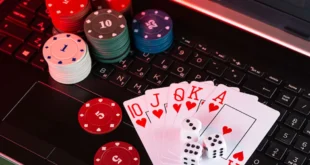Reading poker tells is a crucial skill in poker, allowing players to gain insights into their opponents’ hands and strategies.
Differentiating between genuine and fake tells can be challenging but rewarding.
What are Poker Tells

Poker tells are subconscious physical, verbal, or behavioral cues that reveal information about a player’s hand or intentions. They can be categorized into three main types: physical, verbal, and behavioral.
Physical tells include body language, facial expressions, and movements. For example, a player might exhibit nervous tics, like shaking hands, when bluffing. Verbal tells involve the words a player uses, their tone of voice, and the timing of their speech. Behavioral tells arae patterns in a player’s actions, such as the timing of their bets or how they handle their chips and cards.
Recognizing your own tells is essential before trying to read others. Self-awareness helps you conceal your emotions and actions better, making you a more formidable opponent. It’s also crucial to understand that not all tells are reliable; some players use fake tells to mislead others. Therefore, context and consistency are key in interpreting tells accurately. By observing and analyzing these cues, players can make more informed decisions and improve their overall strategy.
Common Poker Tells and Their Meanings

It is important to know about different poker tells and what they could mean.
Eye Contact
Eye contact can be very telling in poker. Avoiding eye contact often indicates weakness or nervousness. A player who looks away might be bluffing or holding a weak hand.
On the other hand, prolonged stares can be an attempt to intimidate or mislead opponents. Some experienced players might maintain eye contact to project confidence or to conceal their actual hand strength.
Timing of Actions
The timing of a player’s actions can reveal a lot about their hand. Quick decisions often indicate a strong hand or eagerness to bet, as the player feels confident. Conversely, delays can signal uncertainty or strategic planning, possibly for a bluff. Analyzing the timing helps in understanding the psychological state of the opponent, aiding in making better decisions.
Handling of Chips/Cards
How players handle their chips and cards can also provide insights. Nervous shuffling or hesitation suggests insecurity or a weak hand. Swift, controlled movements typically indicate a strong hand, as the player is confident in their position. Observing these small actions can give clues about the player’s hand strength.
Attentiveness

A player’s level of attentiveness at the table is another key tell. Lack of focus often signals a weak hand, as the player is less engaged. Intense focus, on the other hand, suggests a strong hand or strategic planning. Players with strong hands tend to be more attentive to the actions of others to maximize their potential gain.
Table Talk
Table talk can be very revealing. Players who provide excessive information, either intentionally or unintentionally, are often nervous or attempt to mislead others. Silence, however, can indicate confidence or discomfort. Experienced players may use table talk strategically to confuse opponents or to read their reactions.
Advanced Tells
Professional poker players have advanced ways to tell how their opponents will act.
Intense Staring
Intense staring is often an overcompensation for a lack of skill. Players who stare too intently are usually trying to bluff with a weak hand. They hope to intimidate their opponents into folding. However, experienced players recognize this tactic and can exploit it to their advantage by calling the bluff.
Quick Bets and Tanking

Quick bets can indicate that a player is drawing or bluffing. They want to appear confident to scare others away. Tanking, or taking a long time to act, is often a sign of a strong hand disguised as weakness. The player hopes to lull opponents into a false sense of security, encouraging them to bet more before springing a strong hand on them.
Reaching for Chips Early
Reaching for chips early in a hand is a defensive move that often indicates a weak hand. The player wants to signal strength to deter others from betting aggressively. Recognizing this tell can help opponents call the bluff and apply pressure to force a fold.
Odd or Inconsistent Bet Sizing
Odd or inconsistent bet sizing is usually a sign of bluffing or showboating. Players who vary their bet sizes dramatically may be trying to confuse opponents or project false confidence. Analyzing bet patterns can help in identifying these bluffs and making informed decisions.
Inconsistent Decisions
Inconsistent decisions are a strong indicator of aggression or confidence based on table changes. A player who suddenly shifts their strategy is likely reacting to perceived weakness or strength in others. Understanding these shifts can provide valuable insights into their thought process and hand strength.
How to Hide Your Own Tells

Finally, lets talk about how to hide your own moves.
Consistent Betting Actions
Maintaining a consistent approach in betting actions helps avoid giving away hand strength. By keeping bets uniform regardless of the hand, you become less predictable. This consistency makes it harder for opponents to read poker intentions you have and develop counter-strategies to combat you.
Timing Control
Controlling the timing of your actions deliberately is crucial in avoiding reveals of confidence or uncertainty. By standardizing the time you take to make decisions, you prevent opponents from picking up timing tells. This approach keeps your play consistent and more challenging to read.
Avoid Overacting

Overacting can give away obvious signals. Keeping actions natural and minimal helps in concealing your hand strength. By avoiding exaggerated movements or gestures, you become less readable. The goal is to blend in with the natural flow of the game, making it difficult for opponents to gather clues.
Maintaining Stoic Composure
Keeping emotions in check is vital in preventing reveals of hand strength. A stoic demeanor helps mask any excitement or disappointment associated with your cards. By maintaining a calm and composed appearance, you reduce the likelihood of giving away tells, making it harder for opponents to gauge your position.
The Bottom Line
Reading and understanding poker tells is essential for improving poker strategy. Practice and self-awareness are key to mastering this skill, helping you gain an edge over opponents and make more informed decisions.
 Imagup General Magazine 2024
Imagup General Magazine 2024



